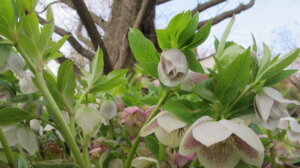The early spring bulbs have been out for a while now and the hellebores are starting to show. Some varieties flower earlier than others and the range is from now until late spring. The flowers remain throughout summer and simply fade, but still look attractive. I never remove them as my attention moves to other plants as the year goes on. They’re a much-commended plant for any garden.
Hellebore is an evergreen flowering plant which means it has all season interest. Since they flower early they are a good source of nectar for emerging solitary bees. They grow nicely in clumps in partial shade in my garden. They are in fairly damp (not wet or dry), well drained loom soil under a deciduous tree. They look great with the daffodils that spring up through and around them.
It’s not an inexpensive item in my local garden centres but they do multiply after about 2-3 years allowing for seedlings to be transplanted. (NB. not all hellebores self seed) My hellebore bed acts very nicely as groundcover. In other locations I have them as border standout plants.
Pretty soon the tired old leaves should be cut off as this affords the best chance for seedlings to grow. Removing the old, desiccated leaves once the new growth appears improves the look of the plant. Other than that they are a fairly low maintenance, low-growing, dependable, highly rewarding perennial.
Hellebores come in a wide range of colours, double petals, and distinctive markings. Sometimes with natural insect cross-pollination their characteristics can change. If you want your hellebore to retain their uniqueness you might consider hand-pollination. Soon will be the time to do this. Hand-pollination not only secures the uniqueness it also provides for the highest seed production.
The video on the Toronto Master Gardener YouTube channel is worth a watch;







Recent Comments